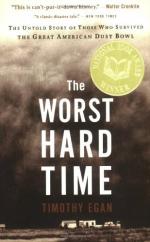|
This section contains 3,717 words (approx. 13 pages at 300 words per page) |

|
The dust bowl was one of the darkest periods of life on America's Great Plains. During that time, a combination of environmental and human-made conditions created a natural crisis unseen before in the twentieth century. Author T.H. Watkins describes the process:
The land had been broken and exposed by repeated plowing, leached of its nutrients by constant planting and replanting, grazed down to the dirt by cattle and sheep, its topsoil skinned off in sheets or gullied by water erosion during wet years. And it was on these lands that the sun had been doing some of its most devastating work during the drought years.
Dry and Dusty History
People had to be tough to live on the Great Plains, and those who did could testify that drought, wind, and blowing dust were common to the region. In 1830, Baptist missionary Isaac McCoy recorded...
|
This section contains 3,717 words (approx. 13 pages at 300 words per page) |

|




